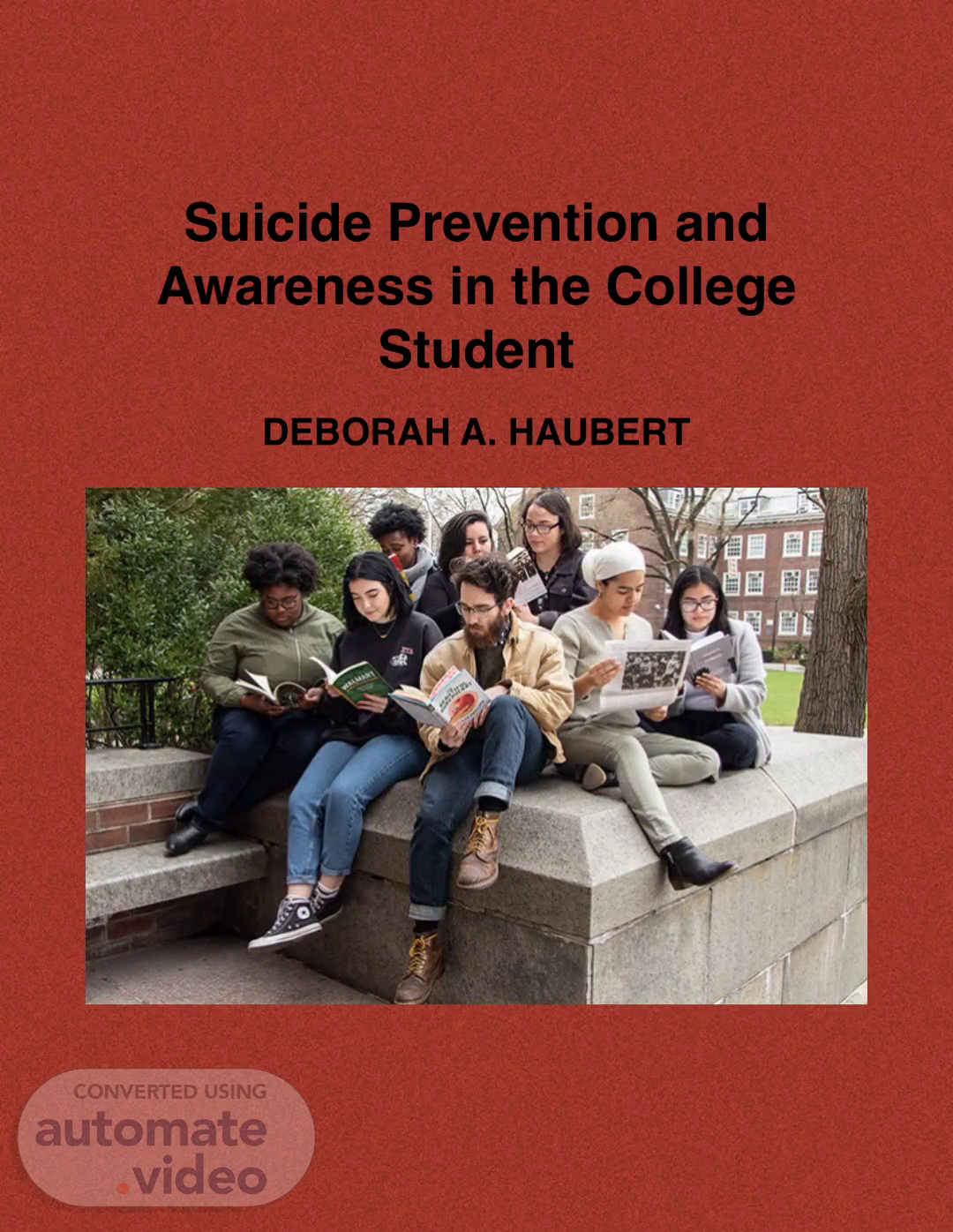Scene 1 (0s)
[Audio] Suicide Prevention and Awareness in the College Student DEBORAH A. HAUBERT.
Scene 2 (12s)
. . 2. THE PROBLEM A variety of factors have been determined to contribute to suicidal ideation and attempts in college students, including loneliness, helplessness, academic problems, relationship problems, difficulties with parents and financial concerns. Transitioning into college life can be challenging.
Scene 3 (25s)
. . 3. STATISTICS In colleges and universities in the United States, suicide is one of the most common causes of death among students. Each year. approximately 24,000 college students attemptsuicide while 1,100 students succeed in their attempt, making suicide the second-leading cause of death among U.S. college students..
Scene 4 (41s)
. . 4. Signs of Suicide Some warning signs that indicate a student may be considering suicide include: • Sudden decrease in school performance. Fixation with death or violence. Unhealthy peer relationships. Violent mood swings or sudden change in personality..
Scene 5 (54s)
. . 5. Symptoms of depression and anxiety can include: Difficulty handling schoolwork Loss of interest in activities, such as clubs, sports or other social commitments Changes in eating or sleeping patterns Emotional outbursts. such as tearfulness or anger Sense of being overwhelmed Panic Faulty self-assessments Lack of energy.
Scene 6 (1m 7s)
. . 6. SCREENING.
Scene 7 (1m 13s)
. . 7. PREVENTION SUICIDE PREVENTION POLICIES - Screening to identify high risk students Social marketing and education to encourage help-seekingand reduce stigma - Restriction of access to lethal means - Training for campus mental health staff to help themidentify and address risk factors - Training gatekeepers toidentify suicidal students and take appropriate actions - Crisis management plans.
Scene 8 (1m 28s)
. . 8. Professional development to help staff and faculty identify at risk students Promote social connections let student know they are there if needed Help to promote health seeking behaivior okay to ask for help Provide mental health and substance abuse.
Scene 9 (1m 41s)
. . 9. Training Faculty and Staff Staff on campus should be trained in assessment, diagnosis, treatment, and management of students who may be at high risk for suicide. Training for mental health staff should be regular and ongoing,.
Scene 10 (1m 52s)
. . 10. EDUCATIONAL RESOURCES SPRC promotes collaboration among a wide variety of partners and builds capacity in evidence-based suicide prevention strategies that save lives. EDC SPRC staff: Substance Abuse and Mental Health Services Administration (SAMHSA) provides several screening tools and companion scoring instructions..
Scene 11 (2m 5s)
. . 11. Social Marketing Creating and sustaining an 2nvironment that encourages helF is an essential component of a :omprehensive suicide prevention policy. The goal is to create a campus culture in which mental health disorders are de- stigmatized and there is broad awareness of how to access mental health services.
Scene 12 (2m 19s)
. . 12. RESOURCES; CAMPUS MENTAL HEALTH LOCAL MENTAL HEALTH PROVIDERS SUICIDE PREVNETION STAY HOTLINE HEALTHY 800-273-8255.
Scene 13 (2m 26s)
. . 13. RESOURCES Ittps://www.dph.illinois.gov/sites/default/files/pu blications/suicide-ncollege.students-050216.pdf Signs of suicide ittps://www.mayoclinichealthsystem.org/hometo wn-health/speaking-of-health/colle e-students- and-depression Sympionetoq dvr"ion https://cssrs.columbia.edu/documents/clinical• practice-screener-recent/ COLUMBIA SCALE https://www.nami.org/BIogs/NAMl• Blog/September•2019/Suicide-Prevention-for• College-Students prevention.
Scene 14 (2m 50s)
. . 14. https://www.asccc.org/sites/default/files/P T050213_SuicidePrevention.pdf https://www.edc.org/suicide-prevention- resource-center-sprc.
